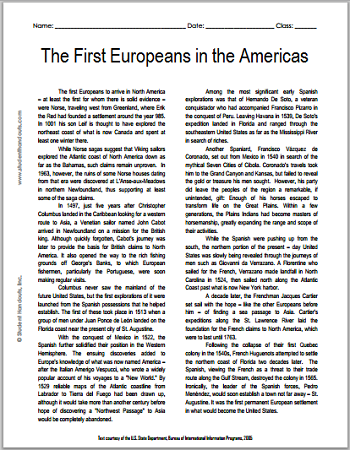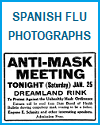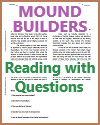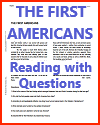| The First Europeans in America Reading with Questions |
|---|
| www.studenthandouts.com ↣ American History ↣ American History Readings |
|
The first Europeans to arrive in North America—at least the first for whom there is solid evidence—were Norse, traveling west from Greenland, where Erik the Red had founded a settlement around the year 985. In 1001 his son Leif is thought to have explored the northeast coast of what is now Canada and spent at least one winter there. While Norse sagas suggest that Viking sailors explored the Atlantic coast of North America down as far as the Bahamas, such claims remain unproven. In 1963, however, the ruins of some Norse houses dating from that era were discovered at L'Anse-aux-Meadows in northern Newfoundland, thus supporting at least some of the saga claims. In 1497, just five years after Christopher Columbus landed in the Caribbean looking for a western route to Asia, a Venetian sailor named John Cabot arrived in Newfoundland on a mission for the British king. Although quickly forgotten, Cabot's journey was later to provide the basis for British claims to North America. It also opened the way to the rich fishing grounds off George's Banks, to which European fishermen, particularly the Portuguese, were soon making regular visits.  Columbus never saw the mainland of the future United States, but the first explorations of it were launched from the Spanish possessions that he helped establish. The first of these took place in 1513 when a group of men under Juan Ponce de León landed on the Florida coast near the present city of St. Augustine.
Columbus never saw the mainland of the future United States, but the first explorations of it were launched from the Spanish possessions that he helped establish. The first of these took place in 1513 when a group of men under Juan Ponce de León landed on the Florida coast near the present city of St. Augustine.With the conquest of Mexico in 1522, the Spanish further solidified their position in the Western Hemisphere. The ensuing discoveries added to Europe's knowledge of what was now named America—after the Italian Amerigo Vespucci, who wrote a widely popular account of his voyages to a "New World." By 1529 reliable maps of the Atlantic coastline from Labrador to Tierra del Fuego had been drawn up, although it would take more than another century before hope of discovering a "Northwest Passage" to Asia would be completely abandoned. Among the most significant early Spanish explorations was that of Hernando De Soto, a veteran conquistador who had accompanied Francisco Pizarro in the conquest of Peru. Leaving Havana in 1539, De Soto's expedition landed in Florida and ranged through the southeastern United States as far as the Mississippi River in search of riches. Another Spaniard, Francisco Vázquez de Coronado, set out from Mexico in 1540 in search of the mythical Seven Cities of Cibola. Coronado's travels took him to the Grand Canyon and Kansas, but failed to reveal the gold or treasure his men sought. However, his party did leave the peoples of the region a remarkable, if unintended, gift: Enough of his horses escaped to transform life on the Great Plains. Within a few generations, the Plains Indians had become masters of horsemanship, greatly expanding the range and scope of their activities. While the Spanish were pushing up from the south, the northern portion of the present—day United States was slowly being revealed through the journeys of men such as Giovanni da Verrazano. A Florentine who sailed for the French, Verrazano made landfall in North Carolina in 1524, then sailed north along the Atlantic Coast past what is now New York harbor. A decade later, the Frenchman Jacques Cartier set sail with the hope—like the other Europeans before him—of finding a sea passage to Asia. Cartier's expeditions along the St. Lawrence River laid the foundation for the French claims to North America, which were to last until 1763. Following the collapse of their first Quebec colony in the 1540s, French Huguenots attempted to settle the northern coast of Florida two decades later. The Spanish, viewing the French as a threat to their trade route along the Gulf Stream, destroyed the colony in 1565. Ironically, the leader of the Spanish forces, Pedro Menéndez, would soon establish a town not far away—St. Augustine. It was the first permanent European settlement in what would become the United States. The great wealth that poured into Spain from the colonies in Mexico, the Caribbean, and Peru provoked great interest on the part of the other European powers. Emerging maritime nations such as England, drawn in part by Francis Drake's successful raids on Spanish treasure ships, began to take an interest in the New World. In 1578 Humphrey Gilbert, the author of a treatise on the search for the Northwest Passage, received a patent from Queen Elizabeth to colonize the "heathen and barbarous landes" in the New World that other European nations had not yet claimed. It would be five years before his efforts could begin. When he was lost at sea, his half-brother, Walter Raleigh, took up the mission. In 1585 Raleigh established the first British colony in North America, on Roanoke Island off the coast of North Carolina. It was later abandoned, and a second effort two years later also proved a failure. It would be 20 years before the British would try again. This time—at Jamestown in 1607—the colony would succeed, and North America would enter a new era. |
|
Directions: Read the text above, then answer the questions below. 1. According to available evidence, who were the first Europeans to reach the Americas? 2. Whose explorations provided the basis for British (English) claims in North America? 3. What European explorer traveled to what is now Florida in 1513? 4. What European country conquered Mexico? 5. Describe the travels and explorations of Hernando De Soto. 6. Describe the search for the Seven Cities of Cibola. 7. What areas of North America were explored by Jacques Cartier? 8. What was the first permanent settlement in what would become the United States? 9. Who founded the English colony at Roanoke? Click here for a printable (.pdf) version of this page that can be reproduced and given to students. |
 |
 |
 |
 |
 |
 |
| Early America Books and Films | Early America Image Galleries |
| Early America Learning and Study Games | Early America Miscellany |
| Early America Outlines and PowerPoints | Early America Worksheets |
| www.studenthandouts.com ↣ American History ↣ American History Readings |








